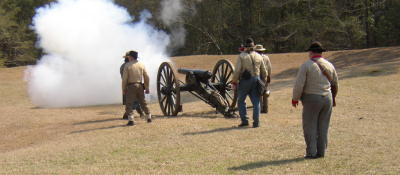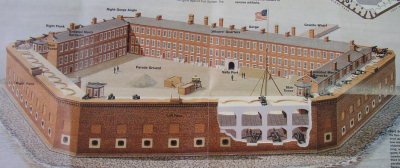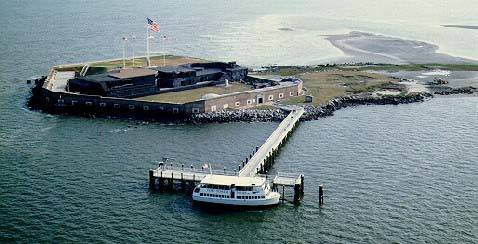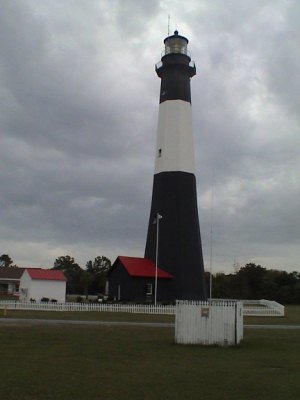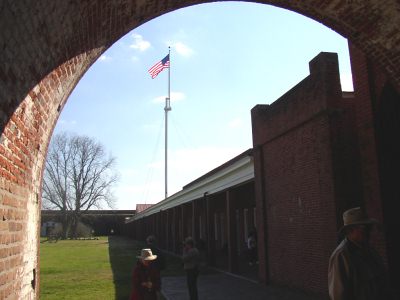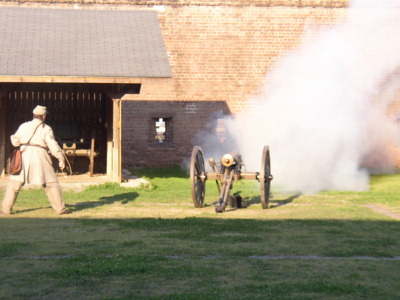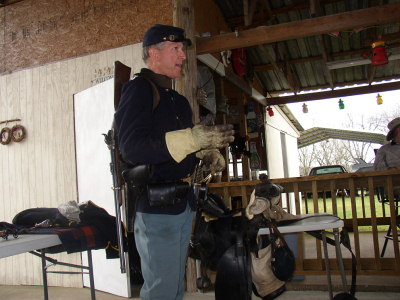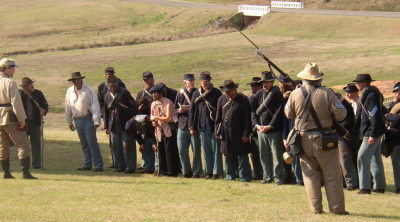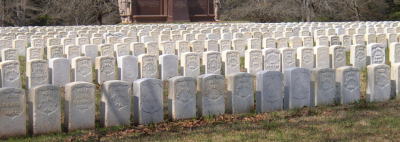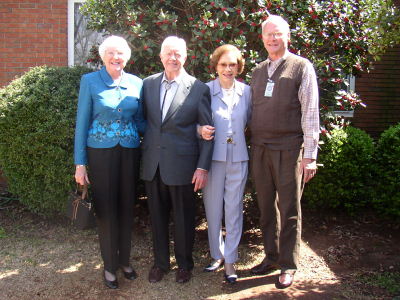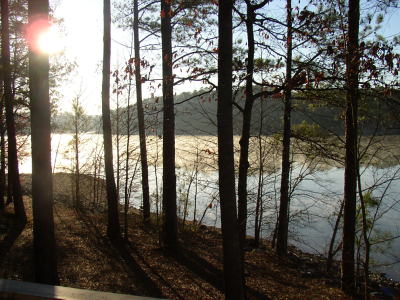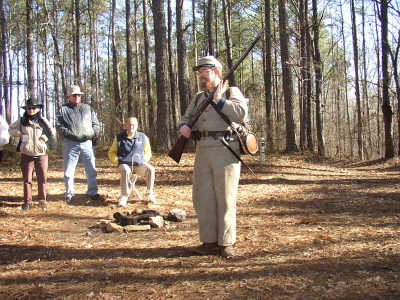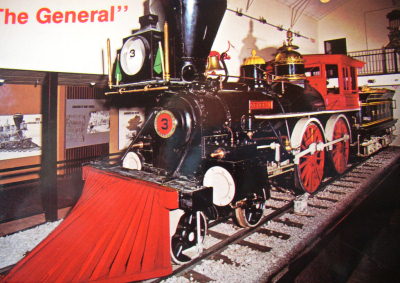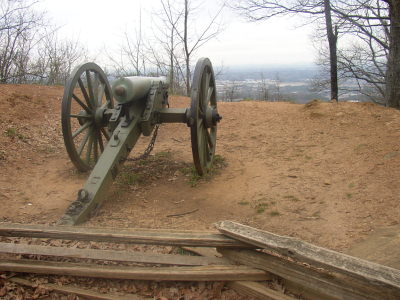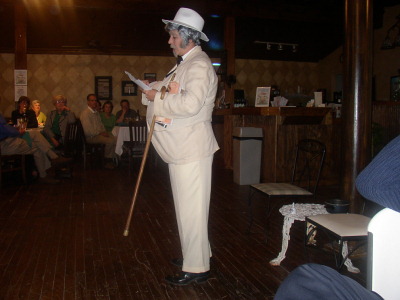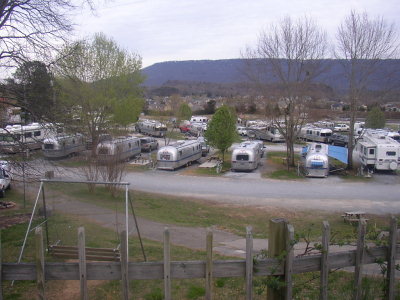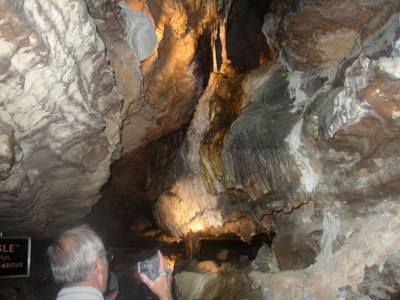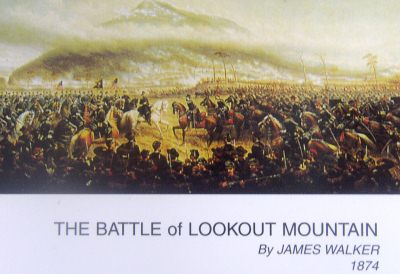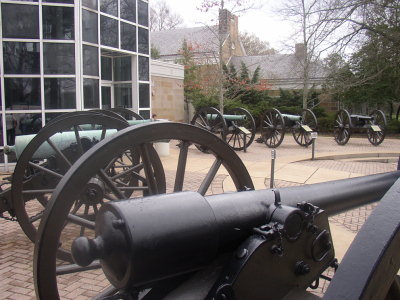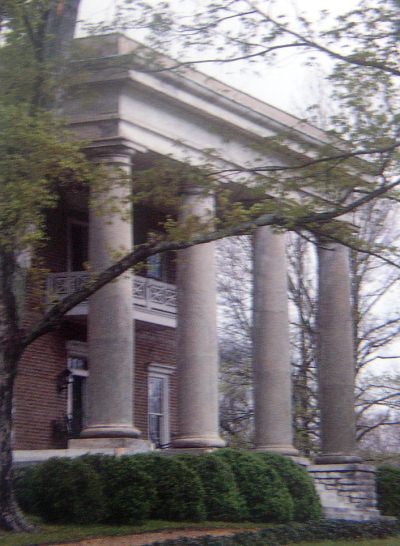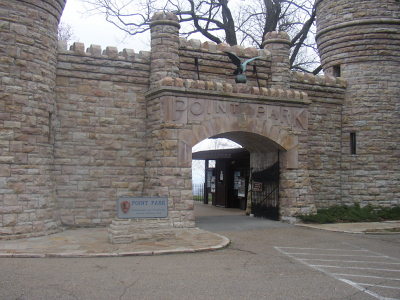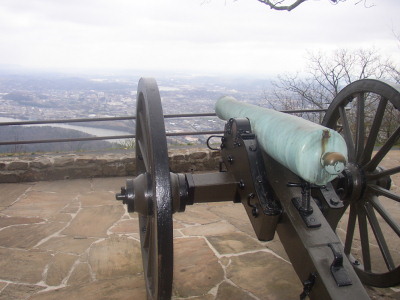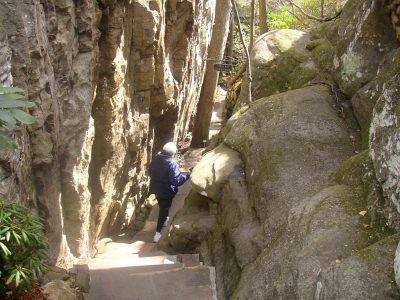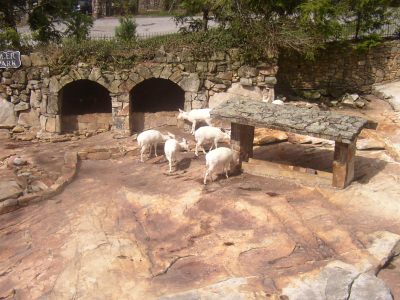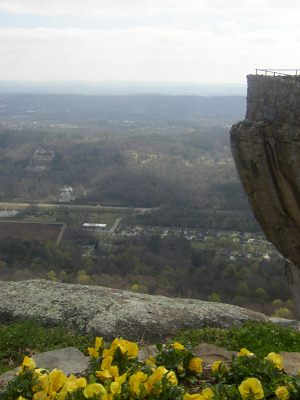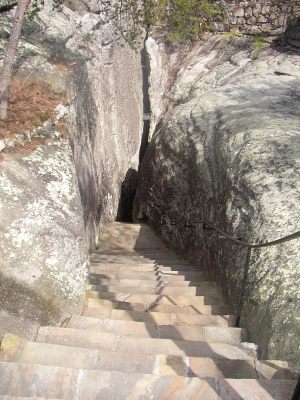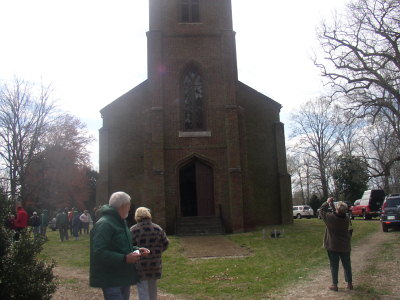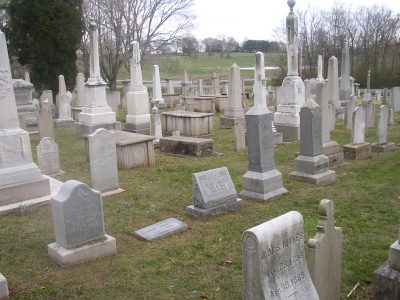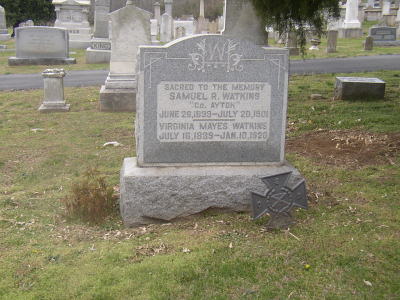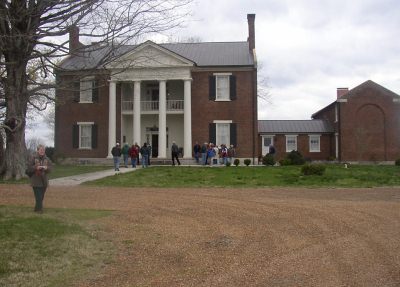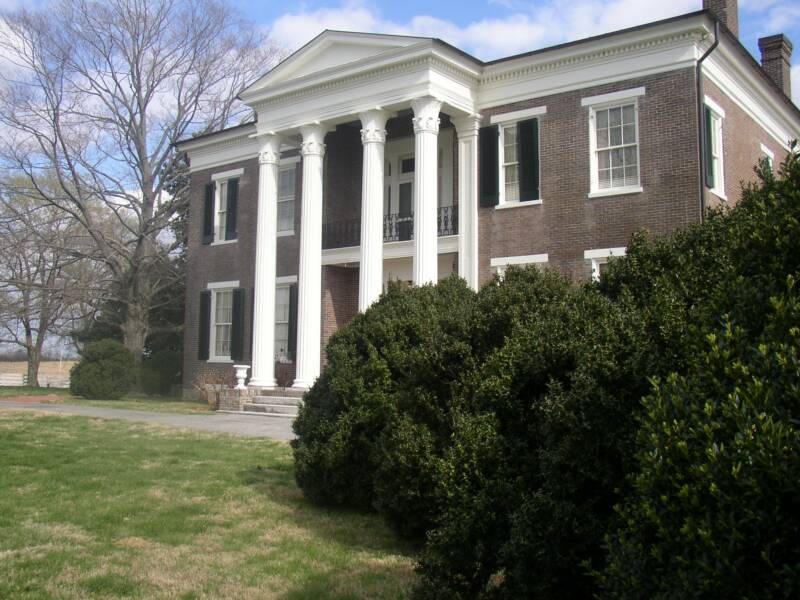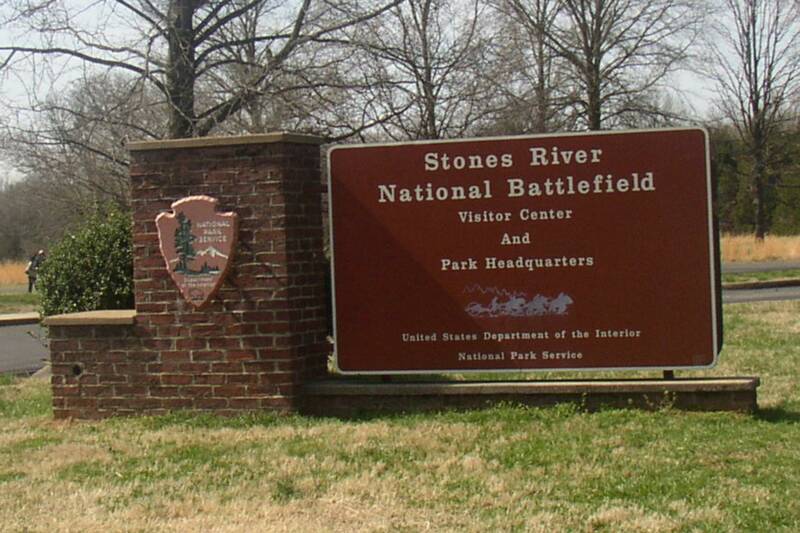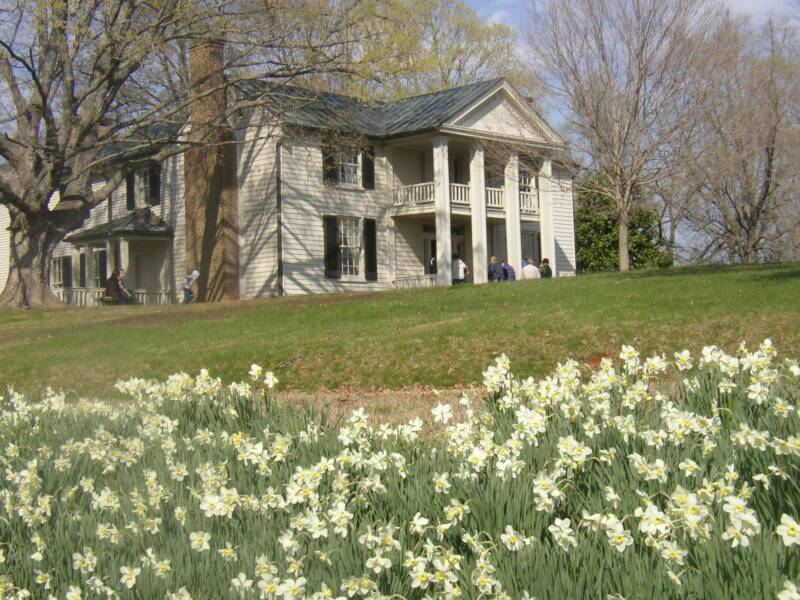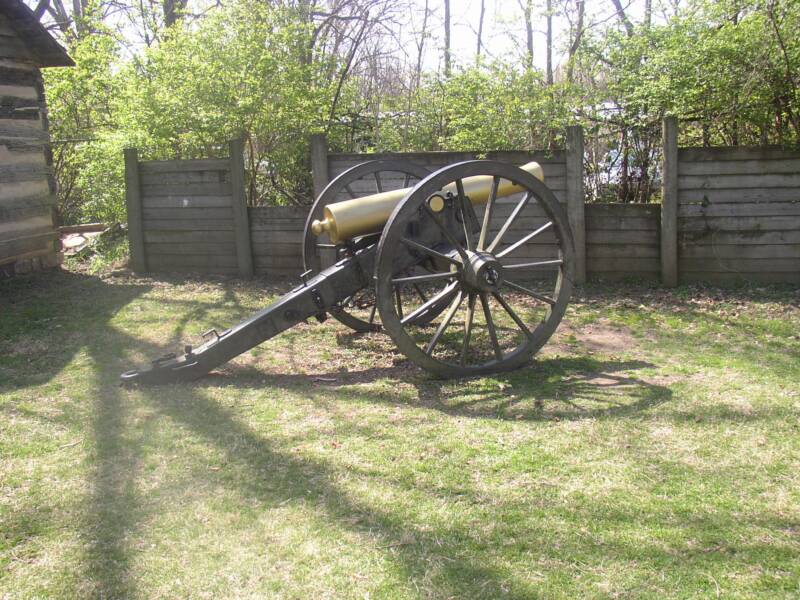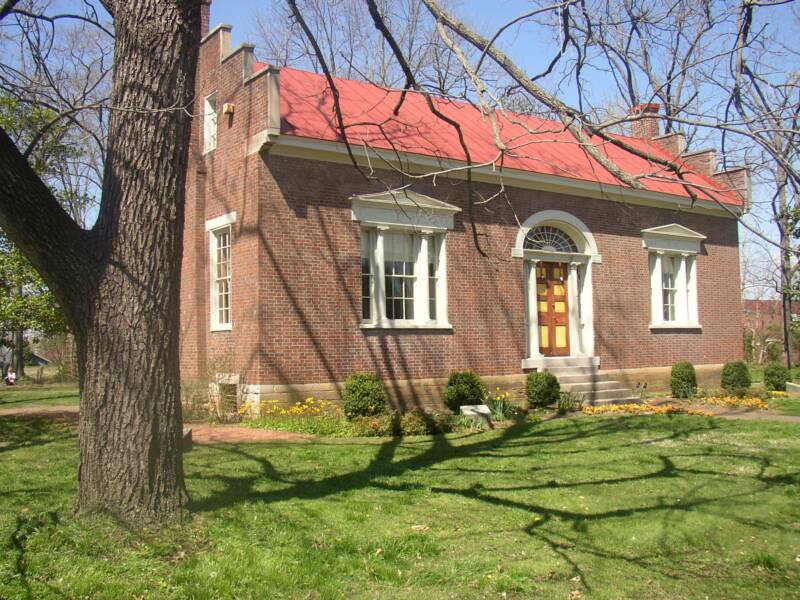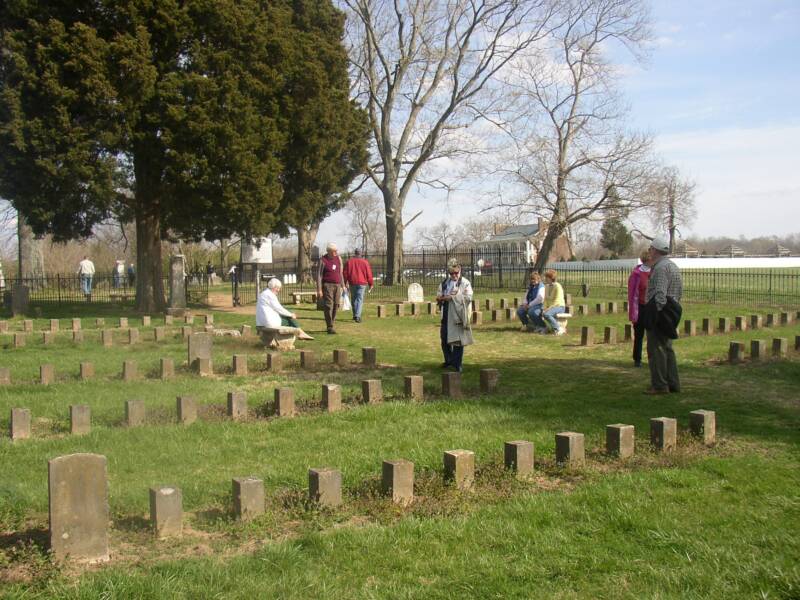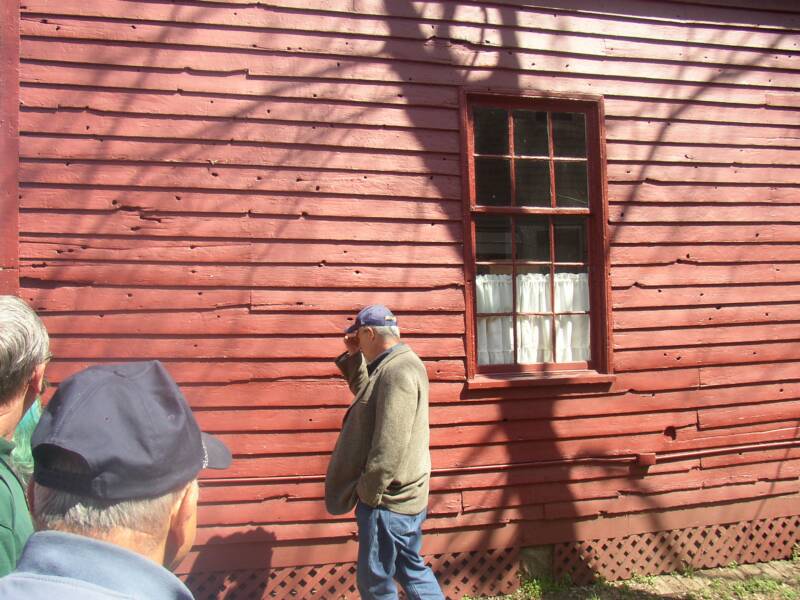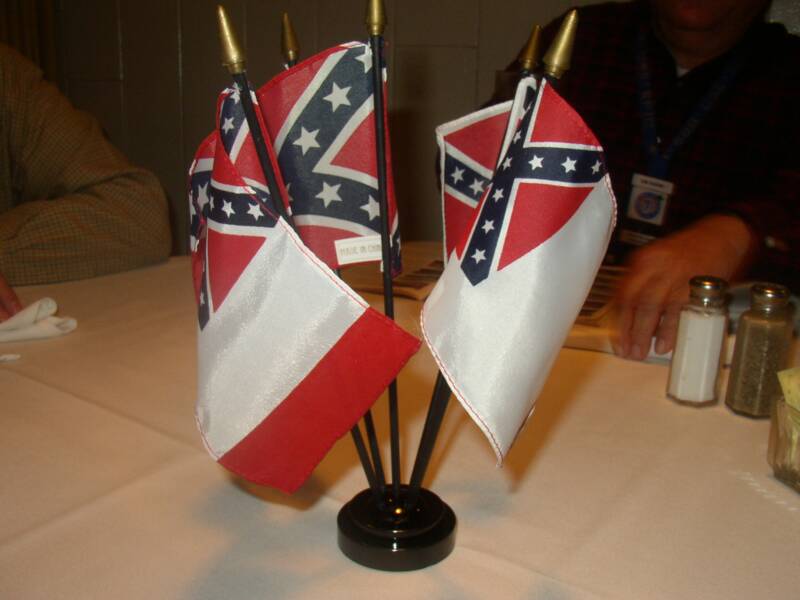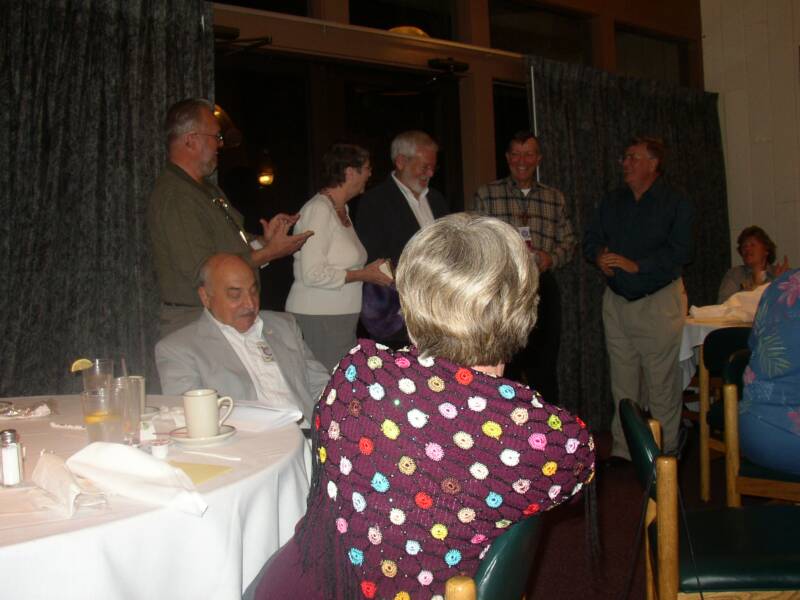NATIONAL CIVIL WAR CARAVAN - PART II
March 2nd - March 29th - 2006
March 1, 2006 - The trip to Charleston was smooth and uneventful -
Clayton to Clemson to Columbia to Charleston. Arriving at the
rendezvous site about 3pm, we exchanged greetings with several
couples that we had caravanned with before, met the leaders, Carol
and Larry Strong, and had a few minutes to rest before a chicken pot
pie cookout on an over-the-water deck in the park.
March 2, 2006 - Gray Line tour buses were at our campsite at 8:45am
to take us on a tour of Charleston. The weather was clear and cool -
in the 60s - but very windy. Charleston is a bustling city now, but back
during the Civil War, the city was severely damaged by bombardment
from Union batteries. Sherman practically ignored Charleston on his
infamous march through Georgia and the Carolinas, so destruction
during the war was not complete.
To say that the Civil War was a tragic event in this country’s history is an extreme understatement. In addition to the million plus soldiers who were killed in combat, thousands more died of disease - cholera, dissentery, pneumonia - contracted from exposure to the elements with inadequate clothing, poor food, and unsanitary conditions. That doesn’t count civilian casualties or describe the miseries endured by everyone in the paths of the war. So, while we are visiting historic CW sites for enjoyment, our caravan leaders have
correctly reminded us of the somber side of the story.
South Carolina was the first of the eleven southern states to secede
from the Union. Slavery was the underlying political issue despite
much that has been written about other causes for the war. The first
hostile shots fired in the war occurred right here in Charleston as
Confederate guns opened fire on the Union troops in Fort Sumter.
That was on April 12, 1861, almost 145 years ago.
The Gray Line tour buses took us through the historic area of
Charleston, finishing along the shoreline - the area called the Battery.
Homes along this exclusive waterfront sell for five million dollars on
the rare occasions when one comes available. Charleston has been
a city since 1670, and because of its well protected harbor, has
always been a major shipping port. In older times, farm crops -
mainly indigo and cotton - were shipped to England. Nowadays,
containerized vessels sail to and from points all over the world.
Fort Sumter, our final destination of the day, was visible in the
distance from the Battery, lying a little over 3 miles out in the harbor
area. Our knowledgable Gray Line guide, who is also a Civil War
re-enactor, took us to dockside where we caught the tour boat to Fort Sumter.
Fort Sumter is known primarily for being the target of the opening cannon fire of the Civil War, but it has quite an interesting history that goes back to the War of 1812. That war convinced Congress of the need for coastal protection, and Fort Sumter was one of many forts built along the eastern seaboard shortly thereafter. To establish the location, 47,000 tons of granite rocks were brought in by sailing ships from New England and strategically placed in the mouth of Charleston Harbor to form an island and foundation for the fort. Then, seven million bricks were brought out from Charleston kilns to build the fort.
The fort must have been an intimidating structure. It was built in the shape of a pentagon with walls 50 feet high and five feet thick. Three story barracks along three sides were large enough for a garrison of over 700 troops.
The initial bombardment that first day of CW hostilities lasted about 36 hours before the fort was surrendered to the Confederates. No one was killed. However, the next day two men were killed by the explosion of a cannon during the surrender ceremony - the first Civil War casualties. The Confederates held the fort throughout the war, but continued shelling reduced it to rubble. The upper two stories were completely destroyed. What’s there today bears only a superficial resemblance to its original appearance. Most of the rubble has been removed and what’s left of the original walls has been patched up somewhat. It is now a National Monument staffed by Park Service personnel - an interesting place to visit and a visual reminder of the destructive power of war.
We were there an hour before reboarding the little tour boat that took us back to the mainland where the Gray Line buses returned us to camp. The day ended with an ice-cream social for the group.
March 3, 2006 - At 10:00am we carpooled to Middleton Place, a plantation dating
back to the 17th century. The landscaped gardens are the oldest in America with
magnolia trees 200 years old, acres of camelia bushes, azaleas, and many other
varieties of trees and plants. One huge old live oak tree was estimated to be 800
years old. Reflection ponds, geometric pools, lots of ducks, swans, peacocks,
sheep, horse drawn tour wagons, alligators, turtles, made the walking tour very
interesting. The mansion that was once the home of the Middletons was
destroyed by Sherman’s troops during their burning march during the Civil War.
The rubble of the destroyed building is still there. A smaller house was burned,
but the walls remained in tact enough for rebuilding.
The destruction at Middleton is typical of the way the Union troops of Gen.
William Tecumseh Sherman burned and pillaged the plantations throughout
Georgia and South Carolina. Sherman’s march took place toward the end of the war in 1865. Even the freed slaves suffered from the devastation.
Walking for an hour left us with a hearty appetite for a catered buffet lunch that featured many low country dishes. From Middleton we drove to the Citadel, the military school established in 1842, predating the Civil War by 19 years. After visiting the campus museum which contained artifacts from
pre- Civil War times, the war years, and the years following, we were
divided into two groups, each led by a cadet on a tour of the campus.
Citadel cadets were used in many areas by the Confederacy during
the Civil War. Forty-four of them killed in the combat. For 17 years
after the Civil War, the school was suspended with Federal troops
occupying the buildings. Then in 1882 classes were started again,
and it has continued since. General Mark Clark of World War II fame is their most notable graduate.
Every Friday, the 1900 cadets march in review in full uniform before visiting dignitaries. We were honored with seats at midfield. While the seats were in an ideal spot for watching the performance, we were on the west side and in the shade of the setting sun as it got colder by the minute. A bagpipe contingent led the band onto the field followed by the mass of cadets, marching to the band music. They marched around on the parade ground for an hour as we shivered. The cannons boomed as the march ended with the band playing the Stars Spangled Banner.
March 4, 2006 - This was the fourth day of the Civil War II caravan of
2006, a day to remember in Charleston, South Carolina. It began as
we carpooled from our campsite to Drayton Hall, one of many old
plantation homes along the Ashley River. Drayton Hall’s main claim
to Civil War fame is the fact that it is the only plantation mansion in
the area not burned by Sherman’s infamous march through Georgia
and the Carolinas in 1865. It is also the oldest preserved plantation
house in America, meaning that it remains just as it was built without
indoor plumbing, electricity, or central heat.
 The weather was chilly as we toured the old mansion, but the
The weather was chilly as we toured the old mansion, but the
sky was clear, the air was clean, and the sun brightened everyone’s
outlook. Drayton Hall reflects the wealth created in the 18th century by
a rice plantation. John Drayton began building the house in 1738, and
it took four years to complete. It has survived both the Revolutionary
War and the Civil War. Several theories exist as to why it was spared
from burning in the latter. The most likely is that it was used by the Confederates as a hospital for small pox victims, and the Yankee troops had no interest in getting close enough to risk exposure.
 The house has not been furnished with period furniture as many historic places have been. In fact it is not furnished at all. Yet, it is impressive. The brick walls are two and a half feet thick, paneled on the inside with native cypress. Some of the panels are three feet wide, indicative of the huge size of the cypress trees that furnished the lumber.
The house has not been furnished with period furniture as many historic places have been. In fact it is not furnished at all. Yet, it is impressive. The brick walls are two and a half feet thick, paneled on the inside with native cypress. Some of the panels are three feet wide, indicative of the huge size of the cypress trees that furnished the lumber.
 Seven generations of Draytons called this place home, but by the time of the Civil War, the demand for rice had declined, the family had moved away, and the plantation had essentially been abandoned. Except for occasional use as a vacation place, the mansion has not been lived in since. The grounds at one time were landscaped similar to the gardens at Middleton, but they no longer exist. The Drayton family deeded the land to the National Trust in 1974, and at their request is being preserved, rather than being restored, in the state received by the Trust. That just adds to its uniqueness.
Seven generations of Draytons called this place home, but by the time of the Civil War, the demand for rice had declined, the family had moved away, and the plantation had essentially been abandoned. Except for occasional use as a vacation place, the mansion has not been lived in since. The grounds at one time were landscaped similar to the gardens at Middleton, but they no longer exist. The Drayton family deeded the land to the National Trust in 1974, and at their request is being preserved, rather than being restored, in the state received by the Trust. That just adds to its uniqueness.
 Following the Drayton Hall tour, we had lunch as a group at Bessenger’s Barbecue before proceeding to the H.L.Hunley display for our 2:00pm tour. Almost immediately after arriving at the restaurant, we were served a sandwich of barbecued pork and mustard, a huge onion ring, and a batch of French fries which was both unique and delicious.
Following the Drayton Hall tour, we had lunch as a group at Bessenger’s Barbecue before proceeding to the H.L.Hunley display for our 2:00pm tour. Almost immediately after arriving at the restaurant, we were served a sandwich of barbecued pork and mustard, a huge onion ring, and a batch of French fries which was both unique and delicious.
 The H.L.Hunley was a Confederate submarine - the first ever submarine to
The H.L.Hunley was a Confederate submarine - the first ever submarine to
sink an enemy ship. That occurred on February 17, 1864, and the ship was the
U.S.S. Housatanic. The event, however, was both a success and a failure. Most
of the crew of the Housatanic were rescued. Only five Yankees died, while the
entire crew of eight on the Hunley died as the submarine never made it back to
its base.
 For 136 years, the Hunley laid on the bottom of Charleston Bay, 1,000 feet
For 136 years, the Hunley laid on the bottom of Charleston Bay, 1,000 feet
away from where the Housatanic had sunk. It was finally found by a research
team financed by novelist Clive Cussler in 1996. It was raised on August 8, 2000
and placed in a protective fresh water tank in Charleston where
experts have meticulously removed the silt and other extraneous
materials. The artifacts that they have found are extraordinary.
The most notable among the artifacts is a twenty dollar gold
piece that belonged to Lieutenant Dixon, the sub’s commander.
It is bent into a crescent. Legend has it that the coin was given
to Dixon by his girl friend as a good luck piece. He was hit by a
Yankee bullet in the battle at Shiloh and wounded in the leg, but
the coin saved his life by taking most of the bullet’s force. An
ornate ring and brooch with many diamonds was also found near Dixon’s body.
. 
 The skeletons of the crew have been removed and given a hero’s burial in a cemetery in Charleston (2004). Evidence indicates that the interior of the submarine remained dry for twenty years. That leads to the conclusion that the crew died from a lack of oxygen rather than having drowned. Why they didn’t use the pumps to return to the surface remains a mystery.
The skeletons of the crew have been removed and given a hero’s burial in a cemetery in Charleston (2004). Evidence indicates that the interior of the submarine remained dry for twenty years. That leads to the conclusion that the crew died from a lack of oxygen rather than having drowned. Why they didn’t use the pumps to return to the surface remains a mystery.
 How the Confederates found volunteers willing to man the little sub is also a mystery. The space inside was cramped, dark, and dank, with just enough room for the eight men to sit on a narrow bench on one side, crouched over to man a hand crank which turned the propeller at the stern. The space was 38 feet long, 48 inches high, and 42 inches wide.
How the Confederates found volunteers willing to man the little sub is also a mystery. The space inside was cramped, dark, and dank, with just enough room for the eight men to sit on a narrow bench on one side, crouched over to man a hand crank which turned the propeller at the stern. The space was 38 feet long, 48 inches high, and 42 inches wide.
 A 17 foot long spar with a container of 90 pounds of black powder was attached the lower part of the sub’s bow. To set the charge, the sub had to ram the ship to embed the powder keg in the ship’s hull. The explosion was triggered by a 100 yard long line that remained attached to the sub. After ramming the ship, the sub backed away, and when the line reached its end, the charge was ignited. The result was an explosion that tore a huge hole in the hull of the ship.
A 17 foot long spar with a container of 90 pounds of black powder was attached the lower part of the sub’s bow. To set the charge, the sub had to ram the ship to embed the powder keg in the ship’s hull. The explosion was triggered by a 100 yard long line that remained attached to the sub. After ramming the ship, the sub backed away, and when the line reached its end, the charge was ignited. The result was an explosion that tore a huge hole in the hull of the ship.
 At some time in the future when the recovery effort is complete, an appropriate museum is to be built to house the Hunley. It’s present location is more of a research laboratory than a museum. Since the Hunley was the first submarine to successfully sink an enemy ship and thus represents the beginning of submarine warfare, the museum will be historically significant. It was for sure an interesting stop on our caravan.
At some time in the future when the recovery effort is complete, an appropriate museum is to be built to house the Hunley. It’s present location is more of a research laboratory than a museum. Since the Hunley was the first submarine to successfully sink an enemy ship and thus represents the beginning of submarine warfare, the museum will be historically significant. It was for sure an interesting stop on our caravan.
 And thus concluded our day’s activities.
And thus concluded our day’s activities.
March 5, 2006 - Sunday morning and a free day - no caravan activities scheduled. We let Gracie, our GPS gidget, find us a church, settling on the Summerville Baptist Church, just a couple of miles up the road from our campsite. It was another sunny but cool day. Churches around Charleston are plentiful - 181 within the city limits alone. Most are either Baptist or Episcopal. Summerville was a large church, probably with seats for 1,000. Nice service, but though their parking lot was jammed with cars, the church was only about half full. Sounds like a familiar problem: Not enough parking for the capacity of the sanctuary.
Sounds like a familiar problem: Not enough parking for the capacity of the sanctuary.
 We had our first GAM (Get Acquainted Meeting) in the afternoon with John & Judy Hice, Bob & Peggy Gutshall, Jean Hecht, Ken & Nancy Davis, and us meeting on the sunny side of our RV. It was still cold, but we enjoyed the introductions and the snacks anyway. The GAM was followed by a drivers meeting at the Strongs trailer to go over the route to the next campsite near Savannah - Fort McAllister State Park in Richmond Hill, Georgia, 127 miles distant.
We had our first GAM (Get Acquainted Meeting) in the afternoon with John & Judy Hice, Bob & Peggy Gutshall, Jean Hecht, Ken & Nancy Davis, and us meeting on the sunny side of our RV. It was still cold, but we enjoyed the introductions and the snacks anyway. The GAM was followed by a drivers meeting at the Strongs trailer to go over the route to the next campsite near Savannah - Fort McAllister State Park in Richmond Hill, Georgia, 127 miles distant.
March 6, 2006 - Moving from the Charleston area to Savannah was an easy, uneventful 127 mile drive. The advance team - the Strongs, Jones, and Yeates - left at 8:15am and the rest of us about 9:00am. The weather remained cool with a light rain. The sun reappeared during the trip, and spirits remained high as we arrived at Ft. McAllister State Historic Park and settled in.
 Ft. McAllister was part of the defense of Savannah, guarding the Ogeechee
Ft. McAllister was part of the defense of Savannah, guarding the Ogeechee
River access to the port. Not the usual kind of fort, it was constructed of
earthworks. Not only was that an inexpensive way to build, but it was also easy
to repair damage. The fort survived eight attacks from the sea, each time
rebuilding overnight. But the ninth attack came by land, and they weren’t
prepared for that. The fort succumbed on December 13, 1864. Ten days later,
Sherman marched into Savannah. In a telegram to President Lincoln, Sherman
gave Lincoln the city as a Christmas present. That was the end of the war for
Georgia, although it would be another few months before Lee surrendered at
Appomattox.
 The museum at Ft. McAllister has an impressive display of cannon balls and
The museum at Ft. McAllister has an impressive display of cannon balls and
other munitions found around the grounds. We watched a short movie, then
enjoyed a guided tour of the grounds. In 1925 Henry Ford was in the area buying
up cheap land and found the ruins of Ft. McAllister. He decided to restore it and
open it to the public. It was 1964 before that happened though, and then only
because it was eventually deeded to the State of Georgia. It was an interesting
place to walk through, evoking images of what went on there during the War.
 A reconstructed officers quarters provided us a place to have our evening
A reconstructed officers quarters provided us a place to have our evening
meal - Subway sandwiches, chips, and cookies provided by our caravan leaders.
With a fire in the hearth and only candles for light, it was a meal to remember.
March 7, 2006 - With no caravan activities today until midafternoon, we drove out to Tybee
Island to see what we could see and were amazed at the development. Nearly every square
foot of land has been built on - houses, apartments, motels, and businesses. There were
not too many people in evidence, indicating that it is mostly a summer resort area. The
Tybee Island Light Station was an interesting stop, but the accompanying museum was
closed on Tuesdays.
 We met the rest of the caravan at Fort Pulaski at 2:00pm for a guided tour of that
We met the rest of the caravan at Fort Pulaski at 2:00pm for a guided tour of that
interesting place. The fort was built after the War of 1812 when President Monroe realized
that the new nation needed a system of coastal defense. Pulaski was a state of the art
design at the time with walls 7 ½ feet thick, constructed of 25,000,000 bricks, a moat, a
bridge over the moat that could be lifted, a main gate built to withstand a ram, over 300
cannons of the latest design on two levels, and quarters for 600 men. It was considered
to be the gem of the coastal forts, and indestructible. The nearest land mass capable of
supporting artillery was over a mile away on Tybee Island, but the designers never
envisioned rifled cannons. Soon after the Civil War started, the State of Georgia took
possession of Fort Pulaski and turned it over to the Confederacy, and they held it only a
few months. The fort took 19 years to build, but within 30 hours, it was bombarded into submission by the Union’s new rifled cannons on Tybee. Today, the scars of the bombardment are still visible, but the fort is a beautiful sight, well landscaped and well interpreted by the rangers in attendance.
 From Ft. Pulaski we drove a few miles to Old Fort Jackson. The oldest brick
From Ft. Pulaski we drove a few miles to Old Fort Jackson. The oldest brick
fort in Georgia (1808), this fort is closer to Savannah on a spot guarding the last
section of channel to the port facilities. Much smaller than Fort Pulaski or any of
the other forts protecting the harbor, Fort Jackson was Savannah’s last defense
from a navalk attack. It never fell to the Union, but was abandoned after Sherman
captured Savannah from the land. This fort is presently managed by a private
foundation, supported by activities paid for by visitors. We were welcomed by a
bugler who was also our host. Dressed in his Johnny Reb sergeant’s uniform, he
led us into the fort past two sentries to a cannon demonstration and a sumptuous
meal. Instead of eating outside on the parade grounds, because it was cold we
took the barbecued chicken, red rice, Brunswick stew, and cole slaw to one of the
powder magazines. While eating, our host entertained with his guitar and banjo,
singing Civil War era songs. It was an unusual evening meal to say the least.
March 8, 2006 - On this Wednesday morning, we carpooled into Savannah,
parking our vehicles at the Old Savannah Tours terminal. There we boarded
an open air tour bus driven by a guide who enthusiastically described his city
non-stop as we toured the old, squared off city. His spiel, and the tour, lasted
for over an hour. Savannah has made a concerted effort to re-establish the old
homes and buildings in the original town area established by Oglethorpe back in
1730 something. The reconstruction has gone so far as tearing down whole city
blocks to re-establish the area the way it looked before the Civil War. Oglethorpe’s
original layout included 24 squares or parks, around which private homes were
built. Twenty-two of the park squares still exist, and another is being
re-established. Strict building codes ensure that even if a new
building is built, it has to fit into the architectural pattern of the old
city.
 The first time we saw Savannah - probably around 1964, the city
The first time we saw Savannah - probably around 1964, the city
looked like a disaster area - mostly run down slums. Not much had
been done to improve things since the Reconstruction days
following the Civil War. The next time we visited was probably in
the 1980s when we took a self-guided driving tour following the
descriptions and guidance of an audio tape. A remarkable change
had already taken place by then, but there were still many old buildings needing repair. Nowadays, the old city is a beautiful reminder of what life was like before the Civil War when cotton was king in Georgia, and the wealth it created was so evident in the mansions of Savannah. The streets were clean, the houses freshly painted in a variety of colors, the parks were well manicured, the cemeteries well kept. And still there is more work being done.
 Many of our caravaners stayed in town after the tour walking the streets, dining and shopping, with tickets that allowed frequent on and off rides on the tour buses. We watched a historical movie and wandered through the Savannah History Museum.
Many of our caravaners stayed in town after the tour walking the streets, dining and shopping, with tickets that allowed frequent on and off rides on the tour buses. We watched a historical movie and wandered through the Savannah History Museum.
March 9. 2006 - This being a free day, Ann and I went back to town for the Paula Deen tour. Paula Deen is the Savannah lady, famous for her southern cooking on the Food Network and for her restaurant called The Lady & Sons. The four hour narrated tour took us to all of Paula’s favorite places in Savannah while the driver tour guide talked non-stop about Paula. We wound up at Paula’s newest restaurant - Uncle Bubba’s Oyster Bar. Bubba is Paula’s younger brother and runs the place. The parking lot was crowded as we arrived indicating a big crowd inside, but we were expected and were seated right away. Their specialty is a dozen oysters cooked on the half shell over an open fire. We were at a table with five others - two from Kentucky, one from West Virginia, and two northerners - some interesting tablemates. While waiting for our food, Paula, her two sons, and Bubba all came out to greet the guests - an impressive and obviously a successful approach to restauranting.
 Following the tour we drove down to River Street and walked along the waterfront, poking around the many shops.
Following the tour we drove down to River Street and walked along the waterfront, poking around the many shops.
 Our second GAM was held at the Hice’s trailer with the Strongs, the Hilzingers, and the Perruccis. The drivers meeting following was held around a campfire at the Strong’s trailer.
Our second GAM was held at the Hice’s trailer with the Strongs, the Hilzingers, and the Perruccis. The drivers meeting following was held around a campfire at the Strong’s trailer.
March 10, 2006 - This was moving day - from Savannah to Montezuma, about 200 miles. We camped in a small, new campground with limited space. Due to an unusual configuration of sewer connections, we were parked in a big jumble - very disorganized. But all rigs made it in safely and managed to get connected to the essentials.
 One of our caravaners - Ed Jones - is a Civil War re-enactor from Virginia. He
One of our caravaners - Ed Jones - is a Civil War re-enactor from Virginia. He
brought out his cavalry gear to show and told all about how the cavalry worked
and what each cavalry soldier had to carry on his person and on his horse. Some
of what he told us was amazing. For one, at any one time during the Civil War, a
half million horses were involved, and it is estimated that between 1.5 and 2 million
horses were killed in battles. Ed talked for an hour and had everyone spellbound.
We have another re-enactor - John Hice - who plays the part of a medical officer. He
has agreed to tell his story on another occasion.
 Following Ed’s talk we had a lasagna dinner and a birthday cake for all the March
Following Ed’s talk we had a lasagna dinner and a birthday cake for all the March
birthdays, then some instructions from our leaders about our trip to Andersonville
tomorrow and to Plains on Sunday.
March 11, 2006 - What a day this has been! Andersonville. A National Historic Site. What a tragic, horrible story, though well interpreted by the rangers and volunteers and re-enactors. This was a prison camp during the Civil War where Union soldiers captured by the Confederacy were kept. Due to an order by Union General Grant rescinding the prisoner exchange agreement during the war, thousands of prisoners had to be kept somewhere. Andersonville was the place. Designed for a maximum of 10,000 men, they just kept coming because there was no other place. At its peak there were 33,000 men here enclosed in a 26 ½ acre stockade, only 20 acres of which was high ground. That’s over 1600 men per acre of ground. That was in mid-1864 near the end of the war. The men were just marched into the gates of the stockade and left to their own devices - with no shelter but what they could devise themselves.
 A small stream flowed through the stockade that provided the only available
A small stream flowed through the stockade that provided the only available
water. At the downstream end of the stream the latrine consisted of a board
suspended over the stream. The men were forced to drink from the water at
the other end, already polluted by runoff from the guard barracks on the hill.
The prisoners got one meal a day which was usually ground up ears of corn,
cob and all. The Confederacy at that point couldn’t even provide food for its
own army, much less the Yankee prisoners.
 Guards were posted every 50 feet along the 16 foot high stockade walls with
Guards were posted every 50 feet along the 16 foot high stockade walls with
orders to shoot to kill anyone who crossed the deadline, a single board fence
that ran along the perimeter about 12 feet inside the outer walls.
 The lack of good food, the unsanitary conditions, the problems associated with exposure to rain and heat, and abuse by the guards caused the highest death rate of any prison anywhere. Compounding the problem, many of the prisoners arrived with unhealed injuries from the battles where they were captured. It is estimated that 45,000 men spent time in Andersonville, and that about 13,000 men died there. That doesn’t count those who died after release from the diseases contracted in the camp. After visiting the stockade area and hearing the story, it’s really surprising that the death rate was not much higher.
The lack of good food, the unsanitary conditions, the problems associated with exposure to rain and heat, and abuse by the guards caused the highest death rate of any prison anywhere. Compounding the problem, many of the prisoners arrived with unhealed injuries from the battles where they were captured. It is estimated that 45,000 men spent time in Andersonville, and that about 13,000 men died there. That doesn’t count those who died after release from the diseases contracted in the camp. After visiting the stockade area and hearing the story, it’s really surprising that the death rate was not much higher.
 At one point near the end of the horrible year, when the water in the little stream had become impossible, a lightning strike during a thunderstorm fractured the ground, and a new spring bubbled up. The men thought it an act of divine intervention and named it Providence Spring. A shelter has been built now to protect that spring as it still flows.
At one point near the end of the horrible year, when the water in the little stream had become impossible, a lightning strike during a thunderstorm fractured the ground, and a new spring bubbled up. The men thought it an act of divine intervention and named it Providence Spring. A shelter has been built now to protect that spring as it still flows.
 Re-enactors were playing out the parts throughout the day, from
Re-enactors were playing out the parts throughout the day, from
early morning when a group of new prisoners were marched into
the north gate to a candlelight and campfire tour of the prison
ground after dark where we heard the moans and groans and
begging of the hungry prisoners. We saw demonstrations of rifle
and cannon loading and firing. We saw the guards shoot down a
prisoner who crossed the dead line. We watched two movies in the
visitor center. We drove through the cemetery where all those men
were buried. We went to the train station where the prisoners were
unloaded from boxcars. And, we heard the story from many
perspectives.
 After the war the prison commander - Captain Henry Wurz - was
After the war the prison commander - Captain Henry Wurz - was
convicted of murder and was hanged in Washington, DC on the
spot now occupied by the Supreme Court building. He was the
only Confederate executed for war crimes following the war. It didn’t
matter that he had nothing to do with the numbers of prisoners that
flooded in. He had nothing to do with the lack of food. He wasn’t
even the first in command for most of the year that all this happened. Conditions were just as bad in other prisons, even the Union prisons, but none other had the high numbers. Tempers were high though, and the public demanded a scapegoat.
 Andersonville National Historic Site now serves as a memorial to all American prisoners of war throughout the nation’s history. One of the movies we watched told of atrocities endured by our POWs in the War of 1812, the two World Wars, Korea, Vietnam, and the Persian Gulf wars, commemorating the sacrifice of Americans down through the years who lost their lives in prison camps.
Andersonville National Historic Site now serves as a memorial to all American prisoners of war throughout the nation’s history. One of the movies we watched told of atrocities endured by our POWs in the War of 1812, the two World Wars, Korea, Vietnam, and the Persian Gulf wars, commemorating the sacrifice of Americans down through the years who lost their lives in prison camps.
 Sandwiched in to the activities in the park was a walking tour of the little town of Andersonville and a dinner prepared for us at the Andersonville Methodist Church. It was a long day, but one deeply appreciated as our Civil War education continues.
Sandwiched in to the activities in the park was a walking tour of the little town of Andersonville and a dinner prepared for us at the Andersonville Methodist Church. It was a long day, but one deeply appreciated as our Civil War education continues.
March 12, 2006 - Several of our caravaners went to Plains this morning to attend Jimmy Carter’s church and hear him teach his Sunday School class. It was the Maranatha Baptist Church. Three tour buses had already unloaded their groups by the time we arrived, and it was still just 8:30am. The line was a couple of hundred long, slowly moving toward the front doors of the church. Secret Service men were scanning
with metal detectors before allowing entry. Eventually, we got in, but had
to sit in the choir loft and look at his back during the class. But for a few
minutes before he started teaching, he turned to face us and allowed picture
taking.
 This was the 391st Sunday School lesson he’s taught since returning to
This was the 391st Sunday School lesson he’s taught since returning to
Plains following his presidency - SS391. That just happened to also be the
designation of the submarine he served on - SS391. He spent the first 10
minutes describing a recent trip to the University of Washington where he
had given a speech and learned of the newest technological advances in
medicine. His lesson then centered around how he was convinced that
there was no conflict between what man has learned about our universe
through science and the belief that God created the universe.
 Following the worship service (the sermon was by a visiting revival pastor), the Carters - Rosalind and Jimmy - posed with anyone who wanted their picture made with them.
Following the worship service (the sermon was by a visiting revival pastor), the Carters - Rosalind and Jimmy - posed with anyone who wanted their picture made with them.
 In one sense it must be frustrating for the regular church members to be challenged for space by visitors when the Carters are there. In another sense the church treasury must be overflowing with contributions from the visitors.
In one sense it must be frustrating for the regular church members to be challenged for space by visitors when the Carters are there. In another sense the church treasury must be overflowing with contributions from the visitors.
 The only place open for lunch in Plains was Mom’s Kitchen. “Mom” is the black lady who cooked for the Carters for many years. It is her restaurant, and a fine meal it was.
The only place open for lunch in Plains was Mom’s Kitchen. “Mom” is the black lady who cooked for the Carters for many years. It is her restaurant, and a fine meal it was.
March 13, 2006 - We chose to take a day to rest after a busy week while the others carpooled
to Columbus to visit a naval museum. Rest meant a drive to Perry – 20 miles away - to do
the laundry and get the car washed, and for Ann to spend the afternoon ironing.
 At 5:00pm with everyone back in camp, those caravaners with dogs entered a hilarious dog
At 5:00pm with everyone back in camp, those caravaners with dogs entered a hilarious dog
show. Prizes were given for the largest, the smallest, the most obedient, and the prettiest
dog. Two cats also entered the competition. All had a good time. All of that was followed
by a GAM and Drivers Meeting.
March 14, 2006 - This was moving day again, this time to Acworth, Georgia in the
Kennesaw Mountain area. It was our day to serve on the parking committee, so we
went with the caravan leaders and early crew. We took all back roads to avoid going
through Atlanta, missing the prescribed turns a couple of times. By the end of the
day, all caravaners were safely in camp - the McKinney Camground on Lake
Allatoona. All of our campsites were right on a bluff overlooking the lake - beautiful.
The Skippers grilled pork loins and provided everyone with potatoes to cook on
their own. Another great meal.
March 15, 2006 - On this morning our first stop was at the Picketts Mill State Historic
Site near Acworth. The Civil War battle at Picketts Mill, fought in the last year of the
war - 1864, it was the only defeat suffered by Sherman’s forces during his march through Georgia. While the Confederate victory had little effect on the ultimate outcome of the war, it was an embarrassment to Sherman. He
conveniently overlooked any mention of it in his official reports. The battle lasted only a few hours, but 1600 Union soldiers were killed while the Confederates lost less than 500. Just little over three
months later Atlanta surrendered.
 At the historic park an interpretative ranger, fitted out with all the gear a
At the historic park an interpretative ranger, fitted out with all the gear a
Confederateinfantryman had to carry, led us into the woods to a clearing were he
gave a dramatic demonstration of every item. Mixing his presentation with a lot of
humor, he painted a vivid and detailed picture of a Civil War soldier’s rugged life.
 The old mill that leant its name to the bloody battle has long since been gone.
The old mill that leant its name to the bloody battle has long since been gone.
While it survived the war, it burned down shortly after. No record exists to
describe its demise, so the name leant to the battle and a couple of old mill
wheels that are in the museum are all that is left of the mill.
 From Picketts Mill we drove to Kennesaw where a catered lunch awaited us in the
From Picketts Mill we drove to Kennesaw where a catered lunch awaited us in the
old depot - the depot where the famous “Great Locomotive Chase” in the early part
of the Civil War began. After lunch we strolled the streets for an hour, then entered
the Southern Museum of Civil War and Locomotive History. The old locomotive,
the General, is ornately displayed as the centerpiece of the museum. We watched
a movie that described the chase.
 Early in the war twenty-two Union spies came down to Georgia in small groups,
Early in the war twenty-two Union spies came down to Georgia in small groups,
meeting at the depot in the little village of Big Shanty (now Kennesaw) at a
prescribed time. There, waiting for their opportunity, they boarded the General
and took off. The chase began when the theft was discovered. Taking control
of another locomotive, the Texas, which was headed in the opposite direction,
the Confederate railroad men took off after the General - backwards. Overcoming
a number of obstacles thrown out by the General, the chase continued for 90 miles. Sometimes the locomotives reached speeds of 60 miles per hour. It ended only when the General ran out of fuel. The hijackers escaped into the woods, but most were ultimately caught and hanged. The Texas has been preserved and is on display at Grant Park in Atlanta near the Cyclorama.
 A number of other Civil War artifacts are also on display at the museum, including a very good display of the old Glover Machine Works collection. The Glover plant produced locomotives for many years following the war. After touring all of this, we were led outside for another demonstration of Civil War uniforms by a young history major. It was another good day.
A number of other Civil War artifacts are also on display at the museum, including a very good display of the old Glover Machine Works collection. The Glover plant produced locomotives for many years following the war. After touring all of this, we were led outside for another demonstration of Civil War uniforms by a young history major. It was another good day.
March 16, 2006 - The day started with a convoy to the Kennesaw Mountain National Battlefield Park. Kennesaw Mountain was the last major Confederate defense of Atlanta where Federal General Sherman defeated Confederate General Johnston after a long struggle during the summer of 1864. The Confederate cannons that were placed on the
mountain with great difficulty are still there pointed to the north. From
the summit looking to the south, the skyline of Atlanta and Stone Mountain are clearly
visible as part of a panoramic view of the terrain.
 After watching a movie which described the siege of Atlanta, we climbed to the top
After watching a movie which described the siege of Atlanta, we climbed to the top
of the mountain for a look at those cannons. It must have taken quite an effort to get
those guns up there with 19th century horsepower. The air was a bit smoggy over
the city, but the tall buildings of the city were still visible.
 The convoy reassembled about 11:15am for the drive back to downtown Acworth and
The convoy reassembled about 11:15am for the drive back to downtown Acworth and
the Tea Cup Cottage where we had lunch. After lunch the owner of a shop a few doors
down talked to us about the war and escorted us out to Allatoona Pass, a little known
strategic spot which was a Confederate stronghold. This deep cut through a rocky mountain was made for the railroad. It was not only important as a Confederate defense point, but was significant as the path of the Great Locomotive Chase earlier in the conflict.
 The tracks have long since been removed, and the pass is now just a relic in the landscape. We walked through and back, trying to imagine as we went along what it must have been like during those hectic days of the war.
The tracks have long since been removed, and the pass is now just a relic in the landscape. We walked through and back, trying to imagine as we went along what it must have been like during those hectic days of the war.
 The fall of Atlanta was a crippling blow for the Confederacy. When news of the defeat reached the cities of the North, it reinvigorated the resolve of the nation. It was probably the event that decided the 1864 election in which President Lincoln was re-elected. Prior to that important victory pacifists were
The fall of Atlanta was a crippling blow for the Confederacy. When news of the defeat reached the cities of the North, it reinvigorated the resolve of the nation. It was probably the event that decided the 1864 election in which President Lincoln was re-elected. Prior to that important victory pacifists were
screaming for peace, and newspapers were predicting Lincoln’s defeat. At the
same time the fall of Atlanta was demoralizing to the South. The army was
weakened, and the door was opened for Sherman’s march to the sea. 
March 17, 2006 - This was a free day so we took the opportunity to drive over to
Marietta to have lunch with Ann’s sister Ease, then relaxed during the afternoon
until 6:00pm. Then the caravan went together to Acworth and the Cobb Playhouse
Dinner Theater. Actually the theater group came to us at Cotton’s Restaurant to
perform Mischief in the Magnolias.
 Transportation got a little tricky since the campground gates were closed and
Transportation got a little tricky since the campground gates were closed and
locked every night at 9:00pm, and we knew we would be later than that getting
back. Half the vehicles had to be parked just inside the gate while everyone piled
into the other half to travel to town. Upon our return those vehicles had to be
parked overnight outside the gate while we piled into the first group of vehicles
inside to get back home. The meal was good, as was the entertainment, so it was
worth the little inconvenience with the vehicles.
March 18, 2006 - This was a traveling day - this time to Chattanooga, Tennessee, our
next to last stop where we camped at the Raccoon Mountain RV Park. The trip was
uneventful except for meeting up with Fran and Dave Perrucci at a Cracker Barrel
restaurant.
 With some free time after arrival, we drove to Ruby Falls. Neither of us had ever
With some free time after arrival, we drove to Ruby Falls. Neither of us had ever
been there before and didn’t have any idea what we were about to see. Ruby Falls
is an underground waterfall buried deep within Lookout Mountain. To get to the
falls we descended 260 feet in an elevator, then walked through narrow cavern
passages for a half mile. Lights were strategically placed along the cavern to
highlight various formations given names like Cactus and Candle, the Crystal
Chandelier, the Potato Chip, the Angel’s Wing, the Onyx Column, the Leaning
Tower, Elephant’s Foot, Dragon’s Foot, etc. At one point we were 1,120 feet directly
below the summit of Lookout Mountain.
 Finally we arrived at the falls, and they were awesome. Within a natural
Finally we arrived at the falls, and they were awesome. Within a natural
chamber that appeared to be about 50 feet across, the water poured out of a rock
145 feet above us. The flow rate was about 500 gallons per minute - the water
falling into a pool with no apparent outlet. Obviously, there had to be an outlet,
but none was visible. The pool was 4 to 5 feet deep.
 We were far from alone in the cavern. Our group had about 45 people in it, and
We were far from alone in the cavern. Our group had about 45 people in it, and
there were about ten other groups in the cavern at one point or another - some
going, some coming single file. About 375,000 visitors are guided through the caverns to the falls each year.
 The falls are named after Ruby Lambert, wife of Leo Lambert, the man who discovered the falls. He had raised funds to drill an elevator shaft down to a known cavern 420 feet below when he discovered a new cavern just 260 feet down. It was while investigating the new cavern that he found these unusual falls. It’s hard to imagine the stamina it took to crawl through the narrow passageways (then only a foot or so high) a half mile into the absolute darkness. He went on to develop the falls into a attraction for the public. He completed it in 1930 when the country was in the Great Depression, and two years later he went broke. Ironically, the present owners are making a killing though with the admission of $13.50 per person plus all they make off the concession stands and gift shops.
The falls are named after Ruby Lambert, wife of Leo Lambert, the man who discovered the falls. He had raised funds to drill an elevator shaft down to a known cavern 420 feet below when he discovered a new cavern just 260 feet down. It was while investigating the new cavern that he found these unusual falls. It’s hard to imagine the stamina it took to crawl through the narrow passageways (then only a foot or so high) a half mile into the absolute darkness. He went on to develop the falls into a attraction for the public. He completed it in 1930 when the country was in the Great Depression, and two years later he went broke. Ironically, the present owners are making a killing though with the admission of $13.50 per person plus all they make off the concession stands and gift shops.
 We finished the day with a few Joker games with Winston and Carol Montague.
We finished the day with a few Joker games with Winston and Carol Montague.
March 19, 2006 - After breakfast at the Cracker Barrel with the Montagues, Skippers, and Strongs, we attended the Lookout Valley Presbyterian Church. It was a small, but very friendly group of people and a meaningful service. That afternoon some of the caravaners did some sightseeing around town while others just relaxed in camp, us among the latter.
March 20, 2006 - We awoke to a rainy, cold day in Chattanooga. Despite the cold, we carpooled up Lookout Mountain to Point Park. It was too foggy and cold to walk through the park, so we settled on watching an electronic presentation of the battles for Chattanooga. While a recorded narrative with battle sounds for background played, we watched a model of the topography of Lookout Mountain, Missionary Ridge, and the valley between. Lights focused on the various sites of battle as the narrative told of what went on there in the Fall of 1863. It is called a three dimensional electronic map. The battle for Lookout Mountain took place on a day much like our day today with
fog, rain, and cold, so it might be said that what we were seeing was historically
accurate.
 Next door is the National Park Service ranger office where an unusual painting
Next door is the National Park Service ranger office where an unusual painting
of the Battle of Lookout Mountain is displayed. This 13' x 30' canvas was
painted by James Walker, an eye-witness to the battle. The artist was
commissioned by General Joseph Hooker - paid $20,000 - to memorialize the
battle. Beautiful in detail, the painting took the artist two and a half years to
complete.
 At the beginning of the battles for Chattanooga in September of 1863, the
At the beginning of the battles for Chattanooga in September of 1863, the
Confederate army held all the strategic strongholds, but they were
outnumbered by the Federals - as much as 10 to 1. Still, it took some three
months before the siege was over. Lookout Mountain fell first, then Missionary
Ridge on November 25th. Walking on the battlefields will have to wait until
another day as the weather turned nastier.
March 21, 2006 - This was Chickamauga day. We left the campground at 8:45am for
the 17 mile ride back to Georgia and the Visitors Center at the Chickamauga
battlefield. A multimedia presentation there told the story of the Confederate
victory through the eyes of two veterans who were attending a reunion of sorts
25 years afterwards. It was a case of the Confederates winning the battle but
losing the war. Following that presentation, a ranger took us on a driving tour
of the 6,000 acre National Military Park. The first of its kind, this park was
established in 1890.
 The ranger was a walking encyclopedia, overloading us with battlefield facts -
The ranger was a walking encyclopedia, overloading us with battlefield facts -
names of brigade and battalion commanders, where they were at each stage
of the battle, how many men were killed and wounded, and how the generals
on both sides were confused about the state of things. With little communication
between units, victory or defeat was more the result of luck or circumstance than
good planning. It was a bloody affair, on the 19th and 20th of September, 1863, with
each side losing about 18,000 men.
 Control of Chattanooga was the object of all this fighting. The town itself with only 2500 residents at the time was of little importance, but its location on the Tennessee River and the major rail hub that was there made it important as a supply route for the invasion of Georgia. It was, in effect, the gateway to the South for the Union troops. The Confederate victory at Chickamauga was short lived. The Federal troops merely retreated to
Control of Chattanooga was the object of all this fighting. The town itself with only 2500 residents at the time was of little importance, but its location on the Tennessee River and the major rail hub that was there made it important as a supply route for the invasion of Georgia. It was, in effect, the gateway to the South for the Union troops. The Confederate victory at Chickamauga was short lived. The Federal troops merely retreated to
Chattanooga and waited for reinforcements, then three months later launched the attacks on
Lookout Mountain and Missionary Ridge that we had learned about the day before.
 Some 250 of the 500 cannons involved in the battle are still at the site along with monuments all
Some 250 of the 500 cannons involved in the battle are still at the site along with monuments all
along the roadways marking where various units were located.
 After that tour, we drove to the town of Chickamauga for a buffet lunch and a tour of the Gordon
After that tour, we drove to the town of Chickamauga for a buffet lunch and a tour of the Gordon
Lee Mansion. This large old homestead was built between 1840
and 1847 by James Gordon and his 21 slaves. When the Civil
War came along, the mansion was commandeered by General
Rosecrans of the Union Army. It then became a hospital for the
wounded and remained such when the Confederates took over
after the battle. The house was an interesting brick structure.
Even the interior walls were made of brick.
March 22, 2006 - The day began overcast and cold - 29 degrees -
but by noon the skies cleared to a gorgeous clear blue. We
revisited Point Park, the National Park Service site at the tip
end of Lookout Mountain. There’s not really much there to
see aside from the panoramic view of Chattanooga. There’s
a monument there to the New York contingent of the Union
army in the Civil War and a couple of cannons.
 After visiting Point Park, we drove along the ridge line through an unusual
After visiting Point Park, we drove along the ridge line through an unusual
mountaintop residential community about three miles to Rock City. We’ve seen
signs on barns for years that advertised See Rock City, but had never been
there - never really understood what it was.
 Opened to the public in 1932, the park area remains in private ownership.
Opened to the public in 1932, the park area remains in private ownership.
It is just what the name implies - a rock city - through which a pathway
wanders. The pathway, called the Enchanted Trail, has been constructed
through a maze of giant boulders. The trail reaches its most scenic location
at Observation Point where flags are flown of the seven states that can be
seen on a clear day - Georgia, Tennessee, Alabama, Virginia, North and South
Carolina, and Kentucky.
 Along the trail, there are 400 varieties of plant life indigenous to the area,
Along the trail, there are 400 varieties of plant life indigenous to the area,
plants brought in by the owners in the late 1920s. In one enclosed area, there
was a colony of unusual white deer. There was a swinging bridge, a waterfall,
and a cavern with fairyland characters lit with black lighting. There were
some passages through the rock barely wide enough to slip through
sideways. Portions of the trail led through dark, dimly lit tunnels.
 It took about an hour to walk the trail. We might have lingered longer at the more interesting places had it not been so cold, but we were moving along briskly. The crowds were slim too - also because of the cold - which also made it possible to move right along. Now we can say we’ve seen Rock City.
It took about an hour to walk the trail. We might have lingered longer at the more interesting places had it not been so cold, but we were moving along briskly. The crowds were slim too - also because of the cold - which also made it possible to move right along. Now we can say we’ve seen Rock City.
March 23, 2006 - We’re now at the Henry Horton State Park, the last stop of the caravan, in the rolling hills of middle Tennessee near Columbia, the home of James K. Polk, the eleventh president of the United States. Henry Horton was a former governor of Tennessee, and these 1,000 acres were once his estate. The campsites are situated along the scenic Duck River.
 After settling in we all gathered at a picnic shelter equipped with a fireplace. We roasted hot dogs and marshmallows while the Strongs and Skippers made peach, cherry, and blueberry cobbler in their dutch ovens for everyone's dessert. Judging for the best photos made during the caravan in a contest organized by John Hice took place before the picnic. It was an enjoyable evening despite the cold weather.
After settling in we all gathered at a picnic shelter equipped with a fireplace. We roasted hot dogs and marshmallows while the Strongs and Skippers made peach, cherry, and blueberry cobbler in their dutch ovens for everyone's dessert. Judging for the best photos made during the caravan in a contest organized by John Hice took place before the picnic. It was an enjoyable evening despite the cold weather. 
March 24, 2006 - Our first stop on this morning was at St. Johns Episcopal Church near
Mt. Pleasant, Tennessee. This old church building is now only used once a year on
Whitsunday - the Episcopal celebration of Pentecost. It was built in 1842, twenty years
before the Civil War. A family church that fell into disuse in 1910 when the Polk families
moved away, it has no electricity or heating. The church, even though used so little, is
maintained by the diocese in its original state as a historic landmark. The church was
opened just for us by a local historian who told colorful anecdotes about things that
happened around the area during the war.
 The shortest battle of the war occurred practically in the church yard. The Federal
The shortest battle of the war occurred practically in the church yard. The Federal
contingent was hiding in a ravine nearby waiting to ambush the troops of General
Nathan Bedford Forrest. Their problem was that they were using mules for their
transportation. Forrest learned of this and used it to advantage. Mules by their
nature go crazy when exposed to noise - gunfire, shouting, etc. When they panic,
they bray in a high pitched scream and take off running. So Forrest had his men
charge, screaming and shooting. The mules took off, leaving their riders also in panic
and exposed to capture. It was one battle in which there was only one casualty, a
soldier who was run over by the stampeding mules.
 Another story the historian told was about a young girl - Antoinette Polk, the daughter of Andrew Jackson Polk - who had a narrow escape on horseback from oncoming Yankee troops. She warned the Confederates of the Yankee presence, saving them from a surprise attack. As a reward for her assistance, General Forrest gave her a captured U.S. flag. After the war, the Polk family moved to Europe, and Antoinette married and lived in Paris, displaying the flag in her chateau. A couple of years ago, our historian looked up a granddaughter of Antoinette and discovered that she still had the old flag. It is now being preserved for display in the local museum.
Another story the historian told was about a young girl - Antoinette Polk, the daughter of Andrew Jackson Polk - who had a narrow escape on horseback from oncoming Yankee troops. She warned the Confederates of the Yankee presence, saving them from a surprise attack. As a reward for her assistance, General Forrest gave her a captured U.S. flag. After the war, the Polk family moved to Europe, and Antoinette married and lived in Paris, displaying the flag in her chateau. A couple of years ago, our historian looked up a granddaughter of Antoinette and discovered that she still had the old flag. It is now being preserved for display in the local museum.
 The cemetery in the churchyard has several Confederate graves and many Polk
The cemetery in the churchyard has several Confederate graves and many Polk
family graves. This is the same family as that of former President James K. Polk.
 We next visited Zion Presbyterian Church, a church built about the same time as
We next visited Zion Presbyterian Church, a church built about the same time as
St. John, is still thriving. The cemetery on this property also has many Confederate
graves, one being that of Sam Watkins, a war participant who wrote a popular Civil
War book named Company Aytch.
 Lunch time found us at Louie’s Diner in Mt. Pleasant where we enjoyed a barbecue
Lunch time found us at Louie’s Diner in Mt. Pleasant where we enjoyed a barbecue
pork sandwich, potato salad, cole slaw, and baked beans - excellent. Afterward, we
walked around the little town for an hour before driving to Elm Springs, the head-
quarters of the Sons of Confederate Veterans - housed in an old mansion built in
1837. The SCV representative met us at the door in a Rebel uniform and showed us
through the mansion, giving us some more history of the Civil War characters of both
armies who marched through the property.
 The old mansion served as the headquarters of Confederate General Frank
The old mansion served as the headquarters of Confederate General Frank
Armstrong during the war. The Sons of Confederate Veterans offices there now
include an extensive library of Civil War material. There are books upon books listing
then names of soldiers, and just about any other book that has been written about the
war. It was an interesting stop that we would never have found on our own. That, of
course, is one of the advantages of caravanning.
March 25, 2006 - It being a free day from caravan activities, many of our folks drove into Nashville this day to see the Grand Ole Opry. We chose to drive just the 22 miles into Columbia to look around and take care of laundry. Columbia is a good sized town, bustling with traffic. Found a mall that made Ann happy and a free wi-fi hotspot at a Crystal Hamburger stand. So, I got caught up posting this travelog to our website.
 Upon return to camp, I walked a ways along the Duck River. It’s a wide river with a gentle current. Found the remains of an old dam and mill wheel along with lots of flowering trees that mark the coming of Spring. One would be hard pressed to know it was Spring otherwise though. The sun came and went all day, but it was cold - low 40s - most of the day.
Upon return to camp, I walked a ways along the Duck River. It’s a wide river with a gentle current. Found the remains of an old dam and mill wheel along with lots of flowering trees that mark the coming of Spring. One would be hard pressed to know it was Spring otherwise though. The sun came and went all day, but it was cold - low 40s - most of the day.
March 26, 2006 - We attended the First United Methodist Church in Columbia,
Tennessee, then met the rest of the caravan at the Rippavilla Plantation in Spring
Hill for lunch and a tour of the mansion. This old mansion was taken over by the
armies as they moved through the area. Both Federal and Confederate generals
used the house for their headquarters at various times as control of the vicinity
changed hands. One of the bloodiest battles of the war took place here. The guide
that showed us through the house spoke so fast, my poor old brain couldn't process
it so I don't have good facts.
 I don't think that anyone wanted supper after that sumptuous southern cooked
I don't think that anyone wanted supper after that sumptuous southern cooked
meal we had at the plantation. We met at the picnic area later, and around another
campfire enjoyed some hot chocolate and potato chips - and some good fellowship.
March 27, 2006 - Our water hose was frozen again on this cold morning - the fourth
morning in a row. Otherwise, the sun was out, forecasting a good day to visit more Civil War battlefields in middle Tennessee.
 Tennessee was the last state to join the Confederacy and the first state to rejoin the Union after the war. As a border state, many families were divided over the war. There were over 1400 battles fought in Tennessee - second only to Virginia. The area around middle Tennessee suffered greatly during and after the war.
Tennessee was the last state to join the Confederacy and the first state to rejoin the Union after the war. As a border state, many families were divided over the war. There were over 1400 battles fought in Tennessee - second only to Virginia. The area around middle Tennessee suffered greatly during and after the war.
 Riding with James and Cookie Yeates on this day, we visited the site of the battle
Riding with James and Cookie Yeates on this day, we visited the site of the battle
of Stones River near Murfreesboro where the armies of General Rosecrans of the
Union fought the armies of General Bragg of the Confederacy. It was a costly fight
for both sides with over 25,000 casualties on the last day of December, 1862. It was
a cold, miserable winter day with the Union eking out a close win. But it was a win,
primarily because of the blundering of General Bragg. As a result the South lost a
major source of food supplies, and the North won a major supply depot and a clear
route to Chattanooga. The victory for the Union not only opened the way to
Chattanooga, and then to Atlanta, but gave President Lincoln political encouragement
to push forward with the Emancipation Proclamation.
 Ranger Jim Lewis guided us through the battlefields, giving an enlightened interpretation of all that went on. At one point he led us into a field of boulders called the Slaughter Pen where Federal troops were caught by the Confederates. Unable to escape over those huge rocks, they were just slaughtered - another example of the war's tragedy. The tour ended in the cemetery where the Union soldiers killed were buried - a field full of tombstones - a sobering sight to say the least.
Ranger Jim Lewis guided us through the battlefields, giving an enlightened interpretation of all that went on. At one point he led us into a field of boulders called the Slaughter Pen where Federal troops were caught by the Confederates. Unable to escape over those huge rocks, they were just slaughtered - another example of the war's tragedy. The tour ended in the cemetery where the Union soldiers killed were buried - a field full of tombstones - a sobering sight to say the least.
 From the Stones River National Battlefield we drove to Smyrna and the historic
From the Stones River National Battlefield we drove to Smyrna and the historic
home of Sam Davis. Sam Davis was a Confederate scout who was captured and
hanged by the Federals because he steadfastly remained loyal, refusing to rat on
his friends. Wrongfully, he was tried as a spy, even though he was in full Con-
federate uniform when captured.
 Sam Davis was the son of a moderately wealthy planter, Charles Davis, whose
Sam Davis was the son of a moderately wealthy planter, Charles Davis, whose
home was near Smyrna. In 1860 Charles owned 53 slaves, raising cotton, corn,
potatoes, and other farm crops. Sam was the fifth of thirteen children. When Sam
Davis was hanged he became a martyr and hero for the Southern cause. The Davis
home is now owned by the State of Tennessee as an historic site. Sam Davis is buried
on the property in a family cemetery that also includes the tombs of his mother and father
and several other family members. One can only imagine the anguish this family suffered not only because of the loss of a son, but their entire way of life.
March 28, 2006 - On this day we drove up to Franklin, Tennessee with Bill and Susan
Stone. The Civil War battle of Franklin might have been the bloodiest of them all, at
least in terms of numbers of men killed in a short period of time. Officially, 8,575 men
died in five hours.- over 6,000 of them Confederates. The battle began at 4:00pm on
November 30, 1863. This was a last ditch effort by the Army of Tennessee to divert
Sherman from his march through Georgia. It didn’t work. After the battle of Atlanta,
Hood took his army north toward Nashville to harass the Union army. He found them
entrenched around Franklin and made the mistake of throwing his troops en masse
at the Union line. Equipped with new repeating rifles, the Federals just mowed them
down. Men died standing up with no place to fall, the piles of bodies were so high.
The slaughter must have been awful.
 Our first stop was at the Carter House where the battle took place. Walls of the
Our first stop was at the Carter House where the battle took place. Walls of the
house and out buildings are still pock marked with bullet holes. The interpreter guide
eloquently described what went on that fateful day. Sixteen Confederate generals
were lost, and scores of lesser officers. The museum at the Carter House contained
some interesting artifacts. One was an iron coffin that once contained the body of a
Colonel William Shy. A glass face plate on the coffin allowed the deceased’s head
to be viewed. It remained in the ground for 100 years, then vandals broke into it
looking for artifacts. That was in the 1970s. His family removed the remains and
reburied them in a new coffin. Another item on display was the small chain saw
used to remove the leg of General Hood.
 The Battle of Franklin effectively ended the war for Tennessee.
The Battle of Franklin effectively ended the war for Tennessee.
There was one more battle in Nashville, but that was anticlimactic
compared to Franklin. There would be a few more skirmishes in
Virginia, but Appomattox was just a few months away.
 After lunch we drove to the Carnton Plantation a mile outside of
After lunch we drove to the Carnton Plantation a mile outside of
town. This old mansion was the home of Randall McGavock, an
attorney, and his family. After the battle, every house in Franklin
was used in an effort to care for wounded men - the McGavock
being no exception. Used as a hospital, the wounded were brought
there by the hundreds. Doctors used an upper bedroom for an
operating room. They cut off arms and legs and threw them out a
window with no effort to clean up before tending to the next patient.
The floors are still stained with the blood of those men. Over a hundred
were to die in the house that awful night. Four of the Confederate generals
killed in the battle were brought to this house and laid our on the porch
until their families claimed them and returned them to their homes. The
house continued to function as a hospital for six months after the battle.
 The McGavock home (Carnton Plantation) was built in 1826 out of brick
The McGavock home (Carnton Plantation) was built in 1826 out of brick
made on the estate. It is three stories high. After the war the property
changed hands numerous times, and by the 1970s had essentially been
abandoned, occupied only by chickens and goats. In 1977, the owners
offered the estate to anyone who would agree to restore it to its original
splendor. The Carnton Association, a private foundation, was formed to
take possession under those terms and have done a superior job with the
restoration.
 Sixteen months after the Battle of Franklin, John McGavock set aside
Sixteen months after the Battle of Franklin, John McGavock set aside
two acres of his estate for a Confederate cemetery. By then, all bodies of
the Union soldiers killed had been removed to the Stones River Cemetery,
but the Confederate dead had been buried in shallow graves on the
battlefield where they were killed. McGavock led an effort to dig up those
bodies and re-inter them in his private cemetery. 1481 new graves were
dug. Efforts were made to identify the men by going through their pockets,
and a meticulous record book was kept. What a gruesome task that must
have been! The cemetery is also maintained by the Carnton Foundation.
 That tour ended the tours of this caravan. It was another grim reminder of the
That tour ended the tours of this caravan. It was another grim reminder of the
awful carnage that took place in the American Civil War.
March 29, 2006 - With all caravan activities over except for the final banquet this
evening, we had a free day to wander. We drove to the little town of Bell Buckle and
to the Civil War Museum and sutler’s store called the Blockade Runner. This shop
specializes in re-enactor uniforms and period clothing for the ladies. Everything was
on the pricey side, so settled on a hat and a couple of buttons. Then we at lunch at
the Bell Buckle Café with dessert at the Blue Bonnet drug store - an ice cream cone
in a homemade, handmade waffle cone.
 Our final banquet was in the banquet room of the restaurant right on the park
Our final banquet was in the banquet room of the restaurant right on the park
grounds- a delicious meal of prime rib and fixings. John Hice announced the winners
of thephoto contest. Every couple had put six pictures in for judging. He also
announcedwinners for the best hat selector. He had drawn silhouettes of hats on
heads, and wehad to identify the person thus represented.. Fran Perrucci passed
out the journalsshe had meticulously compiled. A good time was had by all, and
then came the tough part - saying good-bye.
